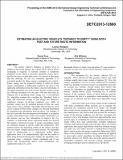Estimating an Electric Vehicle’s “Distance to Empty” Using Both Past and Future Route Information
Author(s)
Wilhelm, Erik; Frey, Daniel; Rodgers, Lennon Patrick
Downloadv001t01a004-detc2013-12880.pdf (952.5Kb)
PUBLISHER_POLICY
Publisher Policy
Article is made available in accordance with the publisher's policy and may be subject to US copyright law. Please refer to the publisher's site for terms of use.
Terms of use
Metadata
Show full item recordAbstract
An electric vehicle’s Distance to Empty (DTE) is defined as the actual distance the vehicle can be driven before recharging is required. A real-time estimate is commonly displayed on the vehicle’s electronic instrument cluster and is used by the driver to plan their route. It is proved in this paper that the challenge for any DTE estimation algorithm is to accurately predict the future energy consumption of a vehicle. Future energy can be predicted reliably if either (i) future energy consumption is sufficiently similar to the past or (ii) applicable information about the future is known beforehand. A stochastic simulation was used to show that the average energy use (Wh/km) measured over the past ∼300 km often does an adequate job at predicting future energy use. A conventional DTE algorithm assumes this condition by “blending” both a long- and short-term average of past energy use. However, significant changes in driving conditions (e.g. traffic or auxiliary energy use) for sustained periods of time can cause large errors in DTE estimates. This paper showed that DTE error can be reduced if those future changes are detected beforehand by obtaining route information from the driver. For example, if the driver provides their destination(s) beforehand, a navigation system could obtain route, traffic and weather information via the internet and use this information to improve the DTE estimate. A multivariate linear regression model was derived that adjusts a historical average of energy consumption based on estimated changes in speeds, traffic and temperature. This method utilizes the measuring ability of the vehicle and thus does not require complex physics-based models. The algorithm could be implemented as a cloud-based mobile phone application since it is computationally light and the model is fitted using historical driving data. Finally, the algorithms were compared using a stochastic vehicle simulation and it was shown that incorporating future route information can significantly reduce DTE error.
Date issued
2013-08Department
Massachusetts Institute of Technology. Department of Mechanical EngineeringJournal
Volume 1: 15th International Conference on Advanced Vehicle Technologies; 10th International Conference on Design Education; 7th International Conference on Micro- and Nanosystems
Publisher
ASME International
Citation
Rodgers, Lennon, Daniel Frey, and Erik Wilhelm. “Estimating an Electric Vehicle’s ‘Distance to Empty’ Using Both Past and Future Route Information.” Volume 1: 15th International Conference on Advanced Vehicle Technologies; 10th International Conference on Design Education; 7th International Conference on Micro- and Nanosystems, Portland, Oregon, USA, August 4–7, 2013. © 2013 ASME International
Version: Final published version
ISBN
978-0-7918-5584-3